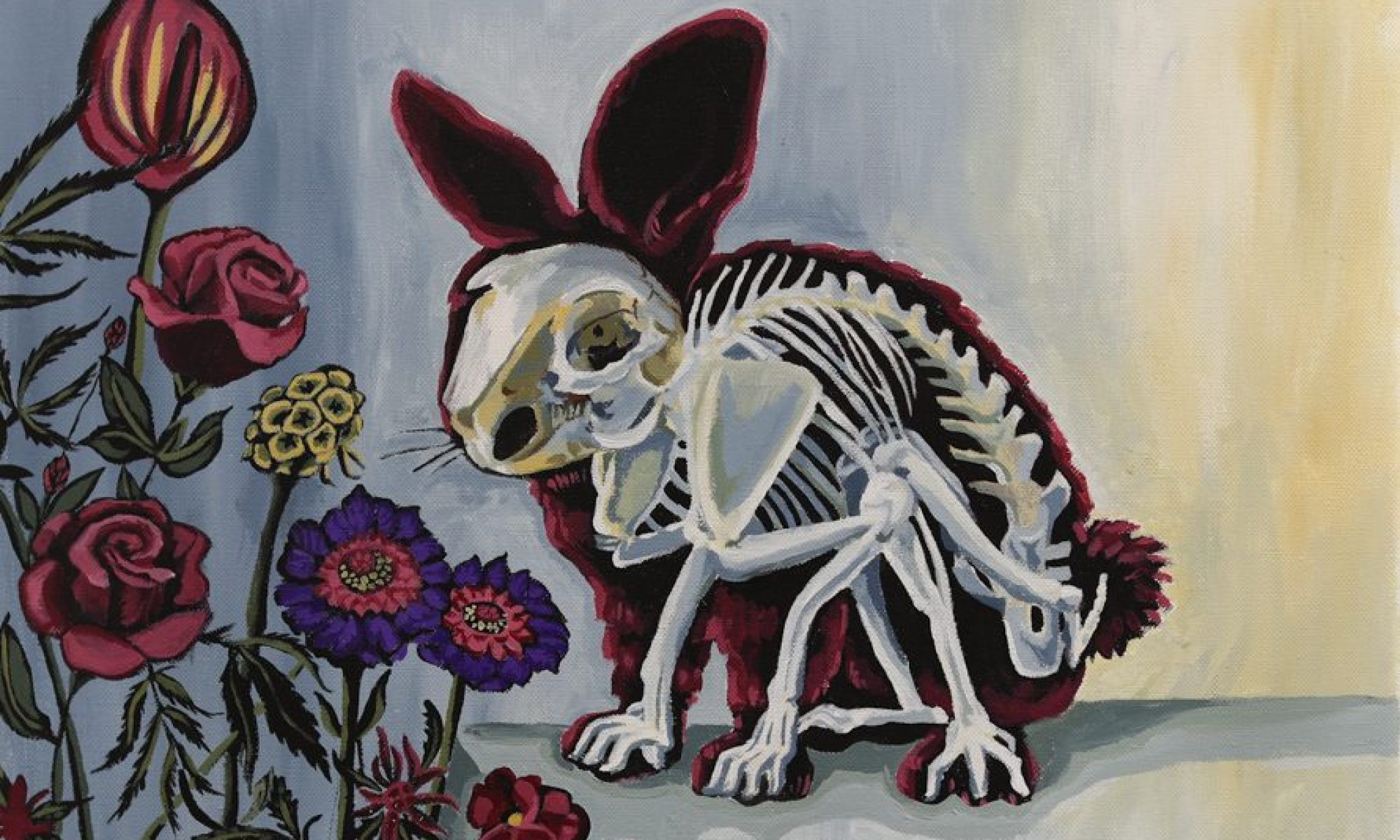Fragile explores the human and wildlife relationship through a series of anatomical animal paintings. Familiar species illustrated in skeleton form balance the beauty of nature with the tragic death lurking in the future. With inspiration from the 17th-century Dutch Still Life, the clustered compositions filled with objects capture the feeling of being overwhelmed – from decaying flowers, plastic bags, chicken wire, orange peels, plinths, and luxurious vases. By focusing on the skeletal structure, the artwork provokes a memento mori – an artistic or symbolic trope that reminds us of death’s inevitability. While bones are the solid foundation of the body, the absence of flesh reminds us how fragile life is for endangered animals. What will happen to the relationships with animals in the future? As our oceans fill with plastic, lakes spill with oil, farming industries abuse their animals, and the atmosphere becomes polluted with fossil fuels, the well-known species will soon be extinct. Each element of this composition strives to reveal human selfishness towards nature and the avoidance of human, animal, insect, and nature endangerment through found objects. Adopting cardboard as a medium allows the viewer to extend their imagination beyond the borders of typical art – contrasting immaculate paintings with typical human waste products.
Rabbitbones, September 2022, acrylic on 18”x 16” canvas
After finding one of my first paintings ever of a rabbit, I decided to transform it into a memento mori. While keeping the original structure of the painting, I make elements of the painting such as the black space, the feminine subjects, and the skeleton body, translating this balance between beauty and death.

Heronbones, October 2022, acrylic on canvas, 23” x 31”

This continuation of the bones series looks deep into the skeleton of a Great Blue Heron and its inherited habitat. The sky is polluted with gray clouds with no vegetation in sight, only the concrete slab it stands on. Its unusual position makes it feel like the heron is being crammed into a box or space it’s not meant to be. Furthermore, this composition reflects the destruction of a species’ habitat and questions the displacement of species for human convince.
Aquarium, December 2022, acrylic on 25”x 50” canvas and 8” x 12” canvas, 16” x 16” x 16” pixie glass cube.





A canvas painting of a sea turtle’s skeleton sits angularly dipping into the opening of a pixie glass cube, resembling an aquarium. Inside the tank sits a betta fish painting in its skeleton form, a common location for these elegant fish in addition to sea turtles. The black space around the animal makes the subjects feel trapped, as is the situation for several endangered animals. This composition creates a deeper understanding of aquatic life and reveals the harmful human impact on ecosystems.
A Bouquet of Dying Flowers, acrylic on cardboard, 17” x 30” x 1”



This baroque-inspired painting reimagines Clara Peeter’s A Bouquet of Flowers, emphasizing death, decay, and the tension between humans and nature. Clustering the composition with objects captures the feeling of being overwhelmed – skeletons of goldfish, butterflies, and a human hand juxtaposed with decaying flowers, leaves, orange peels, and a luxurious vase associated with seventeenth-century Dutch still life. As the skeleton hand picks a petal from the last vibrant flower in the bouquet, it functions as a reminder of human exploitation and the transience of existence. Beneath the acrylic paint is a fibre paste mimicking a bone-like consistency, which activates this human desire for detrimental touch. Using a cardboard medium allows the viewer’s imagination to extend beyond the borders of what is considered typical art – contrasting a pristine painting with a typical human waste product. Each element of this composition strives to reveal humans’ selfishness towards nature and the avoidance of human, animal, insect, and nature endangerment.
Cocks, acrylic on cardboard, 25” x 40”, 2023

While chickens in the 17th century were symbols of wealth and lively stock, when placed in this contemporary context they represent the egg and meat industries that create hostile environments for animals. The composition full of roosters also suggests the topic of infertility in species when placed in hostile environments. Incorporating cracked eggs at the rooster’s feet also represents the worthlessness of male chickens deemed by the egg industry – after being separated from the females, they are disposed of like trash. The cluster of six roosters calls to action to correct current farming industries as on average six chickens are crammed into one cage among all farms in the United States. Using a large-scale cardboard material contrasts a waste product with intricate composition. The painting brings forward the texture of the cardboard, creating feather-like shapes in the small concaved areas of the surface and the chicken coop fence that follows the outline of the concaves. Like the texture, when hung on the wall, the edges of the cardboard itself naturally fold upward, allowing the viewer to recognize the piece as a waste product.






